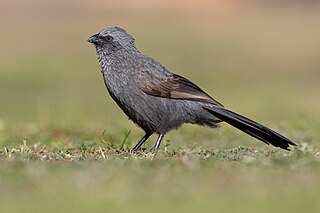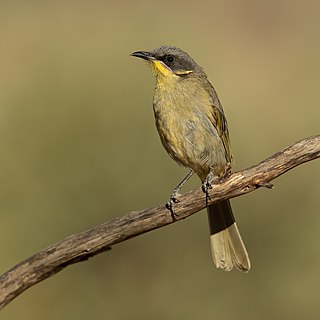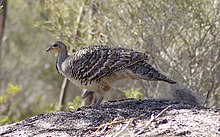
The brolga, formerly known as the native companion, is a bird in the crane family. It has also been given the name Australian crane, a term coined in 1865 by well-known ornithologist John Gould in his Birds of Australia.

The Mallee Cliffs National Park is a protected national park that is located in the Sunraysia region, in the south-west of New South Wales, Australia. The 57,969-hectare (143,240-acre) national park is situated approximately 790 kilometres (490 mi) west of Sydney and 30 kilometres (19 mi) east of the Murray River city of Mildura, Victoria.

The megapodes, also known as incubator birds or mound-builders, are stocky, medium-large, chicken-like birds with small heads and large feet in the family Megapodiidae. Their name literally means "large foot" and is a reference to the heavy legs and feet typical of these terrestrial birds. All are browsers, and all except the malleefowl occupy wooded habitats. Most are brown or black in color. Megapodes are superprecocial, hatching from their eggs in the most mature condition of any bird. They hatch with open eyes, bodily coordination and strength, full wing feathers, and downy body feathers, and are able to run, pursue prey, and in some species, fly on the same day they hatch.

Baillon's crake, also known as the marsh crake, is a small waterbird of the family Rallidae.

The apostlebird, also known as the grey jumper, lousy jack or happy family, is a quick-moving, gray or black bird about 33 cm (13 in) long. It is a native to Australia where it roams woodlands, eating insects and seeds at, or near, ground level. Apostlebirds often travel in groups of about 12; for this reason, they were named after the 12 Biblical apostles.

The diamond dove is a resident bird in Australia. The pigeon predominantly exists in areas near water but which are lightly arid or semi-arid in nature, being Central, West and Northern Australia. They are one of Australia's smallest pigeons along with the peaceful dove. They have been spotted occasionally in Southern Australia in parks and gardens when the centre of Australia is very dry.

The king quail, also known as the blue-breasted quail, Asian blue quail, Chinese painted quail, or Chung-Chi, is a species of Old World quail in the family Phasianidae. This species is the smallest "true quail", ranging in the wild from southern China, South and Southeast Asia to Oceania, south to southeastern Australia, with 9 different subspecies. A failed attempt was made to introduce this species to New Zealand by the Otago Acclimatisation Society in the late 1890s. It is quite common in aviculture worldwide, where it is sometimes misleadingly known as the "button quail", which is the name of an only very distantly related family of birds, the buttonquails.

The greater sooty owl is a medium to large owl found in south-eastern Australia, Montane rainforests of New Guinea and have been seen on Flinders Island in the Bass Strait. The lesser sooty owl, is sometimes considered to be conspecific with this species, in which case they are then together referred to as sooty owls. It is substantially smaller and occurs in the wet tropics region of North Queensland, Australia.

The red-lored whistler is one of nine species of whistler occurring in Australia and a member of the family Pachycephalidae which includes whistlers, shrike-thrushes, pitohuis and allies. The limited range of this endemic bird of the Mallee woodland in one small area in New South Wales and another, larger area encompassing north-western Victoria and adjacent South Australia has seen it listed nationally as vulnerable.

Hampton is an interim Australian bioregion located in southeastern coastal Western Australia, with a small portion (4%) extending into adjacent South Australia. It has an area of 1,088,198 hectares. The Hampton bioregion is part of the Coolgardie woodlands ecoregion.

The giant banjo frog, giant pobblebonk frog, giant bullfrog, or great bullfrog is a species of frog, endemic to Australia, in the family Limnodynastidae. Fry was the first to recognise the species of Giant Banjo Frog as a distinct subspecies of Banjo Frog, differing from the similar Southern or Eastern Banjo Frogs which occupied most of eastern Australia.

Lewin's rail is a species of bird in the family Rallidae. It is also known as the water rail, Lewin's water rail, Lewin's grind rail, slate-breasted rail, slate-breasted water rail, pectoral rail, pectoral water rail, short-toed rail and short-toed water rail.

The red-chested buttonquail is a species of bird in the family Turnicidae. It is endemic to Australia. The species is generally regarded as widespread, although uncommon, in New South Wales, Queensland, northern Western Australia and the Northern Territory, and classified as Vulnerable in Victoria.

The purple-gaped honeyeater is a species of bird in the family Meliphagidae. It is endemic to semi-arid southern Australia, where it inhabits mallee, tall heath and associated low eucalypt woodland.

The grey-crowned babbler is a species of bird in the family Pomatostomidae. It is found in Australia, Indonesia, and Papua New Guinea. Its natural habitats are temperate forests and subtropical or tropical moist lowland forests.

The Yathong Nature Reserve is a protected nature reserve that is also a nationally and internationally recognized biosphere situated in the central-western region of New South Wales, in eastern Australia. The 107,240-hectare (265,000-acre) reserve was listed by UNESCO in 1977 as a Biosphere Reserve under the Man and the Biosphere Programme (MAB). The reserve is significant for its biodiversity in both native plant and animal species. Cultural heritage and historical grazing activities add to the significance of this site as a conservation area.

Gum Lagoon Conservation Park is an 8765 ha protected area about 40 km south-west of Keith in the Limestone Coast region of South Australia. It lies about 20 km inland from the southern end of the Coorong. It contains an isolated block of mallee woodland important for malleefowl conservation.
Ferries McDonald Conservation Park is a protected area in the Australian state of South Australia located in the gazetted locality of Monarto South about 10 kilometres (6.2 mi) south-west of Murray Bridge. It covers an area of 845 hectares and provides a habitat for a range of native and endangered species. It is one of a number of protected patches of remnant mallee bushland within the region. Conservation organisations are now attempting to restore and connect these patches of the fragmented Murray plains in an attempt to heighten the prospects of various rare and endangered species.

The Charcoal Tank Nature Reserve is a protected nature reserve in the central western region of New South Wales, Australia. The 86.4-hectare (213-acre) reserve is situated 10 kilometres (6.2 mi) south of West Wyalong and may be accessed via the Newell Highway and The Charcoal Tank Road. The reserve is an important refuge for native flora and fauna in a highly fragmented landscape, one in which the majority of the original vegetation has been removed.
Taylorville Station is a protected area located in the east of the Australian state of South Australia about 35 kilometres north west of the town of Renmark and about 250 kilometres east of the state capital of Adelaide. It is a protected area which is under the control of the Australian government rather than the Government of South Australia and which is managed by a private organisation under contract. Taylorville Station is part of an area whose habitat has been listed as "critical" for the survival of the bird species, black-eared miner. It is also part of a larger reserve system known as the Riverland Biosphere Reserve.



























